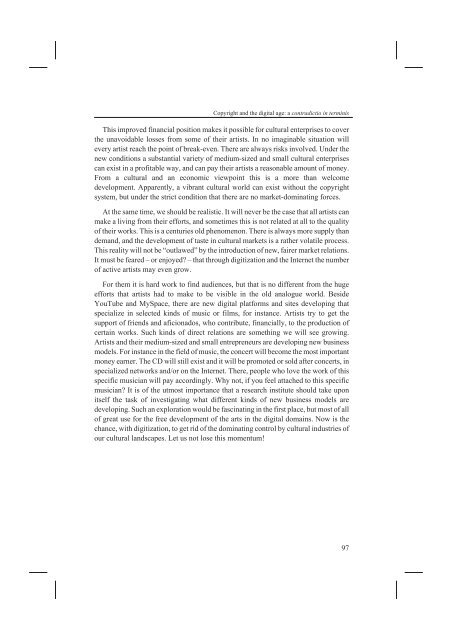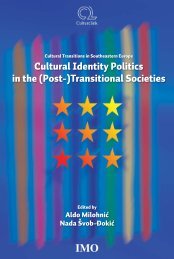D:\Documents and Settings\Ana\My Documents\Biserka-knjiga ...
D:\Documents and Settings\Ana\My Documents\Biserka-knjiga ...
D:\Documents and Settings\Ana\My Documents\Biserka-knjiga ...
You also want an ePaper? Increase the reach of your titles
YUMPU automatically turns print PDFs into web optimized ePapers that Google loves.
Copyright <strong>and</strong> the digital age: a contradictio in terminis<br />
This improved financial position makes it possible for cultural enterprises to cover<br />
the unavoidable losses from some of their artists. In no imaginable situation will<br />
every artist reach the point of break-even. There are always risks involved. Under the<br />
new conditions a substantial variety of medium-sized <strong>and</strong> small cultural enterprises<br />
can exist in a profitable way, <strong>and</strong> can pay their artists a reasonable amount of money.<br />
From a cultural <strong>and</strong> an economic viewpoint this is a more than welcome<br />
development. Apparently, a vibrant cultural world can exist without the copyright<br />
system, but under the strict condition that there are no market-dominating forces.<br />
At the same time, we should be realistic. It will never be the case that all artists can<br />
make a living from their efforts, <strong>and</strong> sometimes this is not related at all to the quality<br />
of their works. This is a centuries old phenomenon. There is always more supply than<br />
dem<strong>and</strong>, <strong>and</strong> the development of taste in cultural markets is a rather volatile process.<br />
This reality will not be “outlawed” by the introduction of new, fairer market relations.<br />
It must be feared – or enjoyed? – that through digitization <strong>and</strong> the Internet the number<br />
of active artists may even grow.<br />
For them it is hard work to find audiences, but that is no different from the huge<br />
efforts that artists had to make to be visible in the old analogue world. Beside<br />
YouTube <strong>and</strong> MySpace, there are new digital platforms <strong>and</strong> sites developing that<br />
specialize in selected kinds of music or films, for instance. Artists try to get the<br />
support of friends <strong>and</strong> aficionados, who contribute, financially, to the production of<br />
certain works. Such kinds of direct relations are something we will see growing.<br />
Artists <strong>and</strong> their medium-sized <strong>and</strong> small entrepreneurs are developing new business<br />
models. For instance in the field of music, the concert will become the most important<br />
money earner. The CD will still exist <strong>and</strong> it will be promoted or sold after concerts, in<br />
specialized networks <strong>and</strong>/or on the Internet. There, people who love the work of this<br />
specific musician will pay accordingly. Why not, if you feel attached to this specific<br />
musician? It is of the utmost importance that a research institute should take upon<br />
itself the task of investigating what different kinds of new business models are<br />
developing. Such an exploration would be fascinating in the first place, but most of all<br />
of great use for the free development of the arts in the digital domains. Now is the<br />
chance, with digitization, to get rid of the dominating control by cultural industries of<br />
our cultural l<strong>and</strong>scapes. Let us not lose this momentum!<br />
97



